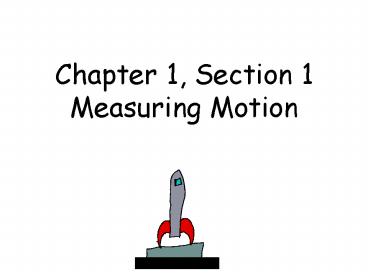Chapter 1, Section 1 Measuring Motion - PowerPoint PPT Presentation
1 / 14
Title:
Chapter 1, Section 1 Measuring Motion
Description:
Chapter 1, Section 1 Measuring Motion When an object changes position over time, the object is in motion. . Motion can be observed by using a reference point. – PowerPoint PPT presentation
Number of Views:339
Avg rating:3.0/5.0
Title: Chapter 1, Section 1 Measuring Motion
1
Chapter 1, Section 1 Measuring Motion
2
- When an object changes position over time, the
object is in motion. - .
3
- Motion can be observed by using a reference
point. A reference point is an object that
appears to stay in place compared to a moving
object. This allows you to tell that the object
is in motion - Reference point Example trees, buildings,
Earths surface
4
- Speed is the amount of time it takes you to
travel a specific distance. - To calculate speed
- Average speed total distance
- total time
- The units for speed are m/s, km/h
5
Objects with speed
6
- Velocity is the speed of an object in a
particular direction.Velocity must include a
direction. - (north, south, left, right)
- To calculate velocity total distance
direction - total time
7
- Velocity is only constant if speed and direction
do not change. Constant velocity is the motion of
a - straight line.
- If there is a change in speed ( 15 m/s to 20 m/s)
or direction (east to west), the velocity will
change.
8
Rocket changing velocity
9
- To combine velocities, it depends on whether the
object is traveling in the same direction or
different direction. The result is the resultant
velocity. - Same direction add velocities together
- 10 m/s north 5 m/s north 15 m/s north
- Different direction Subtract velocities
- 15 m/s west 10 m/s east 5 m/s west
10
- Acceleration is the rate at which velocity
changes. If an objects speed or direction
change, its velocity changes. - An increase in velocity positive acceleration
- A decrease in velocity negative acceleration or
deceleration
11
Roller coaster have positive and negative
acceleration!
12
- To calculate acceleration
- Average acceleration final velocity-starting
velocity -
time it takes to change velocity - a Vf- Vi
- t
- Units for acceleration m/s2
13
- When observing a graph you can determine if
acceleration is positive or negative based upon
the slope. It the slope goes upward it is
positive acceleration. If the slope goes
downward, it is negative acceleration.
14
- Centripetal acceleration occurs when an objects
travels in circular motion. - Example the Earth rotating!































